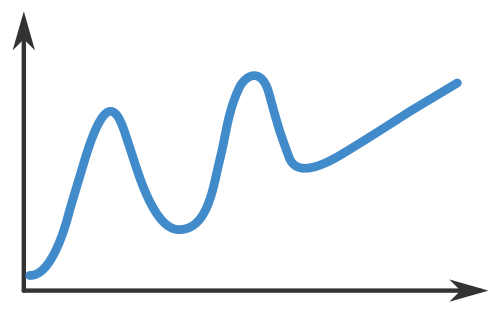Effective Staff Appraisals with Employee Journey Maps
Posted on Nov 19, 2019. Updated on Feb 6, 2023
Employee journey maps are a tool for preparing and structuring staff appraisals. They trigger reflection processes and reveal the employee’s motivation. Moreover, they can lead to interesting insights as they compare the different perceptions of the participants. And the best is: You only need two sheets of paper and a pencil.

TL;DR
- Employee journey maps are a great tool for reflection and to structure and prepare 1-on-1 meetings.
- It’s great to look back and to discover what motivated and what demotivated the employee. We also can reveal how the employee feels.
- The maps can also show how differently certain events have been perceived.
- The usage of the maps signals that we care for the employee’s feelings and motivation.
Preparation
Grab two sheets of paper and draw an empty chart with two axes on it. The x-axis is the time and the y-axis is the employee’s engagement. Alternatively, you can use my prepared PDF or my Diagrams.net template in the downloads section.
An employee journey map starts with two axes: time and employee engagement.
Determine the period that you like to analyze. Usually, this should be the time since the last staff appraisal. Let’s assume that we are doing 1-on-1 meetings every three months.
Let’s talk about the last three months.
Now, both the employee and the manager fill out the chart by answering the two types of questions:
- What was the employee working on? What events and changes have happened to the employee and their environment? This revolves around projects, tasks, challenges, interpersonal relations, impediments, events (meetups, conferences, workshops, hacking days, presentations), organizational changes (in the company, team, roles, and processes), or even changes in the employee’s private life.
- What impact did these events had on the employee? What was motivating and what was demotivating? What went good and what went bad?
An example of a filled out employee journey map
Usage
In the staff appraisal, both participants bring their map, talk about it and compare it. Usually, the employee should talk most of the time. So they should go chronologically from one event to another one in their map and the manager can add their impressions and assessments.
Comparing the employee’s perception with the manager’s can reveal valuable insights
Benefits
- In a staff appraisal, you talk about past events and their impact anyway. Employee journey maps are just a tool to bring more structure into this process and especially into the preparation of a staff appraisal.
- We find out what motivates and demotivates an employee. This is crucial for the employee’s happiness and engagement. We also detect an unhappy employee and can change something before they resign.
- We can compare the self-perception with the perception by others. This is an important point. I never saw that the maps of the participants where identical. This leads to surprising insights: “Oh this meeting was so frustrating for you? I haven’t expected this! Good that you told me.”.
- We show the employee that we care for their motivation and feelings and take them seriously.
- It’s easy to use.
Tips for the Preparation
Depending on the frequency of the 1-on-1 meetings, it can become hard to remember everything that happened. Here are some tips:
- Look up the Git activity. For instance, GitLab provides a nice overview of all commits of a certain user.
- Protocols of the last sprint retrospectives. They usually contain statements about what went good and what went wrong.
- Past meetings in the calendar
- Sent E-Mails
- The protocol and journey map of the last 1-on-1 meeting.
Downloads
- PDF: Empty Journey Map for face-to-face 1-1s.
- Diagrams.net Template for remote 1-1s. The employee can open the file in Diagrams.net (in the browser or the desktop app), adjust it and send it to you during the 1-1.
- Update: I now use a Miro Template instead of Diagrams.net. This way, you can draw the map right in the browser.
Contribution
I like to thank Josephine Woermann from Spreadshirt’s HR department for pointing me to this useful tool.